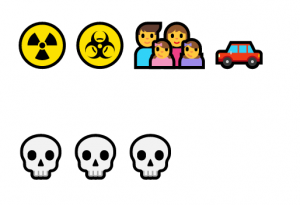For the final exercise of the course, I’ve chosen to present two scenarios related to the topic of my final assignment, which describes text analysis technologies as a way to measure student academic success and mental wellness. In both scenarios, we have a UBC course instructor… let’s say his name is Jordon. Jordon teaches an online English Literature course for first year undergraduate students. As a new(ish) professor not yet on tenure track, Jordon is very interested in the health and wellbeing of his students, and believes that if problems are identifies early on, he can intervene before they grow out of hand. To this end, Jordon utilizes text analysis technology to moderate discussion posts of the students in his class. He’s keen to identify students that may be in danger of straying off the right path. Below are two scenarios as to how this could play out.
Scenario 1- Utopian
As part of the course material for his online English Literature course, Jordon posts a discussion prompt in the form of a question in the discussion forums. Students are expected to apply core concepts from that weeks’ reading material to answer the question, as well as post their own questions to generate further discussion.
Over the course of the first few weeks, Jordon employs LIWC-22 text analysis tools to measure various dimensions of each student’s text, including word count, analytic vs authentic word usage and words per sentence. Early in the course, Jordon notices that there is one student whose textual data skews differently from the rest of the class. The student- James- relies heavily on authentic words as opposed to analytical. James’ writing style is dynamic in that it uses pronouns, conjunctions and negations in much higher frequency than his classmates. Upon closer inspection of James’ actual text submissions, it’s determined that he seems to be writing more about himself than the course material. More than that, James seems to be going through a rough time- he references loneliness, isolation and a recent breakup on more than one occasion. In some instances James doesn’t seem to be interacting with the course material at all, just writing stream of consciousness style responses based on his personal life.
Jordon Reaches out to James to see if how the course is going and if he needs any help with the required readings. James is happy to hear from Jordon- in fact, he mentions that he hasn’t really had direct contact from anyone over the past several months, since his partner left him very suddenly, and he’s been feeling very alone and despondent. Jordon listens to the student, and lets him know that there is support available for him. He passes on the contact information for UBC counselling services and shares some of his own experiences with similar situation from his personal past. James is receptive to the message, and books his first appointment with counselling services the following day. As the days and weeks go by, James’ work in the course starts to improve. He’s engaging with the course material more and making valuable contributions to the discussion forum. James admits he was in a bad situation but didn’t feel he had anyone to reach out to, so many of his issues were coming out in his forum postings. He’s thankful for the early intervention, and his academics and mental health are on their way to getting back on track.
Scenario 2- Dystopian
Same as Scenario 2, Jordon is a new instructor for an online English Literature course, and he intends to use textual analysis technology to monitor the performance and mental health of his students by analyzing their forum posts on a weekly basis.
Once again, a few weeks into the course Jordon’s analysis reveals that a student, James, is contributing a bit differently than his classmates. James’ writing style is dynamic and his word choice is authentic, not analytical. With the best of intentions, Jordon decides that an intervention is warranted, so he arranges for a Zoom chat with James. Things don’t quite go as expected. James is totally taken aback by Jordon’s suggestion that he may not be in a great state of mind. James had no idea that his forum postings were being monitored so closely. He asks why he wasn’t informed that his data would be collected at the start of the course, and questions why UBC doesn’t have a clear policy with regards to use of student data. James reveals that he is from a cultural background with a proud tradition of oral-based knowledge transfer. Based on his prior learning, it makes perfect sense that he would engage with course material in a way that may seem “dynamic” and “personal” compared to his classmates. Additionally, James is currently on a personal journey exploring his own personal gender identity, which is why the use of personal pronouns are more pronounced in his work. If Jordon has bothered to actually read James’s posts closely and consider the inherit biases in the LIWC algorithm, perhaps he would have seen that this was the case.
James is now discouraged from engaging in the course material. He feels he is “under a microscope” and that relating the course reading to his own personal experiences is not a valid approach to learning. James withdraws from the course prior to the withdrawal deadline and discontinues his studies at UBC.
Jordon may have meant well in this scenario, but in his excitement to implement a new learning technology, he totally lost track of the human being on the other side of the equation. It’s a learning experience to be sure. In the future, he vows to inform students of his practices at the beginning of the course, to refer them to relevant institution policy if they have any questions or concerns, and to always remember that technology has its own biases coded into it. Hopefully, this won’t happen again.








